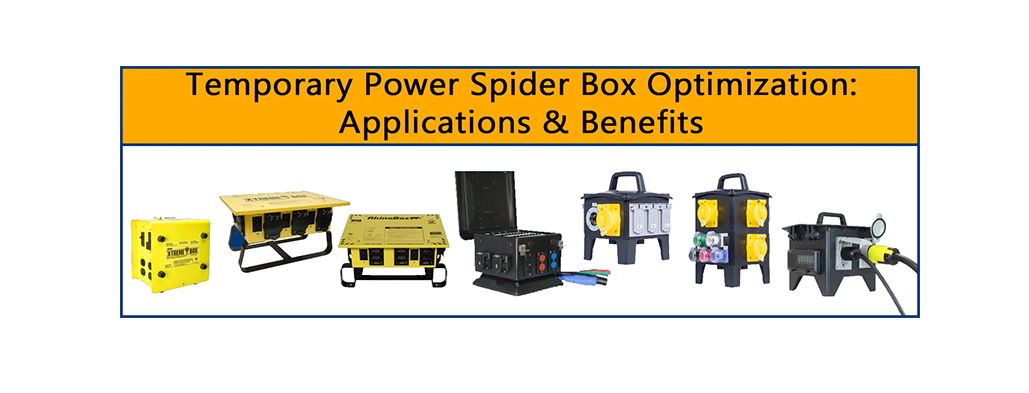
How To Optimize Your Temporary Power Distribution Boxes
Electrical power distribution equipment can be expensive, so why not put your equipment to the test to make sure you’re getting the highest value out of these power boxes? Temporary Power Spider Boxes have so much potential to provide safe, reliable power when and wherever its needed.
You might be thinking – “why would I use a Spider Box rather than a distribution cart and generator”? Well, there’s a few simple reasons as to why this is a better alternative. One common purpose for using these instead of standard equipment is because spider boxes are tiny! That means practically anyone on your team and in the surrounding areas can maneuver them with ease.
Why waste money on large equipment that’s difficult to lug around and risk potential injury on the job? Temporary Power Distribution Boxes are portable electrical boxes that are lightweight, durable, compact, safe, convenient, and they pack a punch! ATI stocks hundreds of different spider boxes that range from 30A up to 200A.
A majority of our power boxes are built from metallic properties and are generally purposed for more industrial temporary power applications. However, we also stock completely rubber boxes that are extremely durable and could potentially last forever if properly maintained. Our experts would recommend our non-metallic power boxes in more diverse industries that have specific needs like the entertainment and marine industry, but they’re not limited to those applications.
In this blog, we’re going to review the reasons why you should choose a portable spider box to provide power throughout your next project. Whether you work in construction, the military, the entertainment industry, or even in damp locations such as the marine industry, we’re confident that ATI has a solution for you.
How to Use a Power Distribution Box
A basic spider box is typically equipped with an input (source) to bring power into the spider box and a few different outputs (receptacles) to provide power outbound. These types of receptacles can vary based on the brand of the power box as well as the application it’s purposed for. You can expect standard 50-amp boxes to include a 15 or 20-amp GFCI outlet, 30-amp twist lock outlet, and a 50A twist-locking receptacle.
It’s important to note that not all boxes are the same. A smaller 30A box like the Mini X-Treme Temporary Power Distribution Center from Southwire will not have the capability to offer 50A power. Therefore, it’s so important to know exactly what you plan on doing with your power distribution unit and what you’re trying to accomplish before making the final purchasing decision. Smaller boxes such as the 30-amp unit will typically use a 30-Amp twist-lock or straight blade receptacle to bring power into the box. However, twist-locks are a much safer option because once connected, they cannot be pulled out of the socket without twisting it counter-clockwise first.
Medium sized systems will often require 50 amps or more for single phase or three phase configurations. These types of power distribution systems are often fed through spider box locking cables for 50A power, pin and sleeve connectors for 100A power, or camlock connectors for more heavy-duty applications exceeding 150 Amps. Each application can vary tremendously based on the industry it’s being used for. Now that you know the three categories – small, medium, and heavy-duty, this can help you determine which type of power distribution box is best suited for your needs.
Temporary Power Distribution Box Applications and Benefits
Portable power distribution boxes can be a great solution for practically anyone. Whether you’re a homeowner, work in construction, or the entertainment industry, a spider box can be an excellent product to add to your toolbox. Medium-duty temporary power distribution boxes are often used in conjunction with spider box locking cables to bring power in, or even “daisy-chain” multiple boxes together for more efficient power distribution. Can you imagine that on a construction site?
Let’s take a look at an example. Try to envision an apartment complex, hotel, or condominium that’s undergoing new-construction and requires sufficient power inside of each unit for the workers. You could simply place a spider box in the hallway, outside of the apartment doors, and run the extension cables down the hallway to the next doorway, where you’d then position another spider box. Finally, connect them together and you’ll have convenient power distribution ready to go into each room.
This same ideology is true for entertainment venues such as concerts, festivals, and carnivals. The power source would begin at the generator and continue throughout the entire area with the help of multiple power distribution boxes and cable assemblies. Now, the last application that we’re going to discuss is a little different because you can’t always plan it out perfectly. Natural disasters happen all over the world and sometimes without warning. This means that if you lose power, you want to be prepared by having a generator and a spider box beforehand because if not, there might not be any left.
Power Distribution Units are utilized in a wide range of industries because there’s practically an endless supply of variations available. If you need a custom power box, ATI is more than capable of engineering a solution tailored to your specific needs as well. If you have any questions or concerns after reading this blog, please don’t hesitate to reach out to one of our experts. Our team is always kind, welcoming, and would be more than happy to clear up any concerns. The portable power group can be reached anytime at PPG@ATIelectrical.com, or visit us on our website to chat with a live agent, or you can even call us directly at (800)-597-9311.

 CALL OR TEXT NOW 800-597-9311
CALL OR TEXT NOW 800-597-9311
Leave a comment